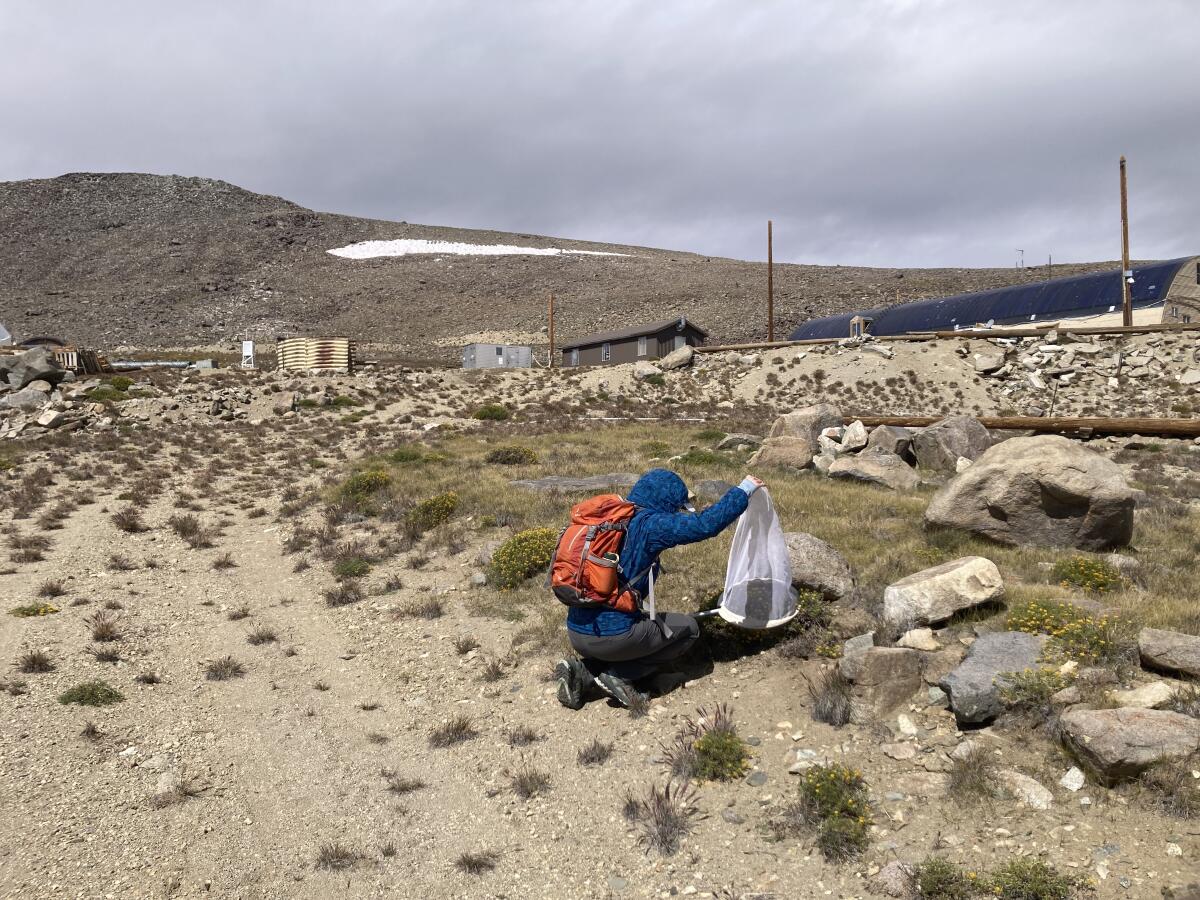UC Irvine researchers study bumblebee gut microbes to help save the bees

- Share via
UC Irvine assistant professor of ecology and evolutionary biology Tobin Hammer, along with his team of researchers, has spent the last few years chasing down bumblebee populations to try to better understand a vitally important part of bee physiology: the bee gut microbiome.
“Bumblebees and honeybees have very specific and beneficial bacteria in their gut, but they also do get infected by pathogens,” Hammer said in a recent interview. “We’re looking at the whole microbial system in the bee gut. It’s fundamental curiosity. The field fairly recently has had cheap and easy tools for characterizing those bacteria ... and all sorts of people are investigating microbial systems.
“Bees are just one of those many environments. Because many bee populations are declining, there’s this urgent need to find out what is causing that and what we might be able to do to stop those declines.”

The U.S. Environmental Protection Agency has documented significant bee declines in recent years, with theories ranging from invasive varroa mites, emerging bee diseases including the gut parasite Nosema, pesticide poisoning, stress, changes to habitat and inadequate foraging or nutrition. Environmentalists have raised the alarm, and scientists and laypeople have rallied behind the cause of “Save the Bees,” seeking out ways to help native bees and other pollinators.
The U.S. Department of Agriculture stated in 2020 that more than 80% of the world’s flowering plants need pollinators to reproduce, and most food comes from flowering plants. The federal agency estimates one out of every three bites of food is created with the assistance of pollinators.
Hammer’s research focuses specifically on native bumblebee species. Around 45 such species exist in North America, but that does not include the honeybee — a nonnative species that was imported from Europe in the 17th century, according to the U.S. Geographical Survey. Both have similar characteristics, Hammer noted, that include being social, living in colonies and making honey, though bumblebees do that significantly less than honeybees do. Both are important pollinators.
But bumblebees tend to be bigger than honeybees. They’re fuzzier and better adapted to cold environments, and Hammer said there are some agrarian plants — tomatoes, eggplants and peppers, for example — that can only be pollinated by bumblebees because of how they pollinate.
In recent weeks, Hammer and his team were in the Eastern Sierra Nevada studying bumblebee populations across a variety of species. He and other researchers asked questions about the kinds of gut bacteria the bees have, what functions the pathogens serve and their prevalence and diversity inside their hosts.

“These are very remote, relatively undisturbed places. In these mountain environments, they’re especially important pollinators. It’s a good opportunity to see how they’re doing and characterize their gut microbes without the same kind of exposure to stressors and other factors you would get with bumblebees in our region for example,” said Hammer, who added they’ve also been studying bee populations and their pathogens in Laguna Niguel and how those change over the seasons.
“We’re also doing lab experiments to see how those pathogens establish in the bee gut. We’re seeing that the kind of native bacteria specific to bumblebees have an important role in defending bees from pathogen infection. They’re more vulnerable when they’re young, similar to humans … but, we still see these infections in the wild. What drives that? And are stressors involved? What are things [humans are] doing to the landscape that might exacerbate disease in bee populations?” he said of their studies.
Hammer and his team have been looking at the relationship between the gut and the brain in addition to other potential factors such as flight performance as bees fly farther and longer to locate food.
“One question is: Does this increased flight effort intersect with disease? Does it affect their immunity? Are there particular microbes that make them better able to fly? One long-term goal that we have is to develop probiotics for bumblebees to improve various measures of health, and that could involve disease resistance, lifespan, reproduction, flight performance and pollination effectiveness,” Hammer said.
Understanding the bee microbiome is just one important piece of that.

“[Microbes] can attribute to declines, but might also provide a solution via probiotics. It could include potentially planting certain flowers or modifying the landscape to support gut health. We know that it’s a really critical contributor to their health. The gut is where they digest food and absorb nutrients and it’s a vulnerable organ for infection. In humans, the microbiome is referred to as a missing organ because it’s almost like there’s this organ that we’re just beginning to understand what it does and how it interacts with the rest of the body.
“This field is very recent. Maybe 10 to 15 years ago, we didn’t know these beneficial bacteria existed [in bees]. We’re really exploring … but the data are already pretty clear that these microbes have major effects on bee health and also on behavior. Everybody loves bumblebees. They’re charismatic, adorable and important parts of our local biodiversity, and we should strive to keep them around as best we can.”
All the latest on Orange County from Orange County.
Get our free TimesOC newsletter.
You may occasionally receive promotional content from the Daily Pilot.








